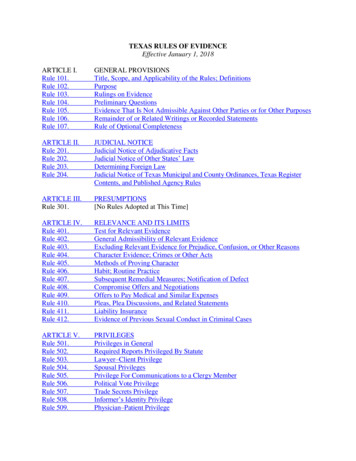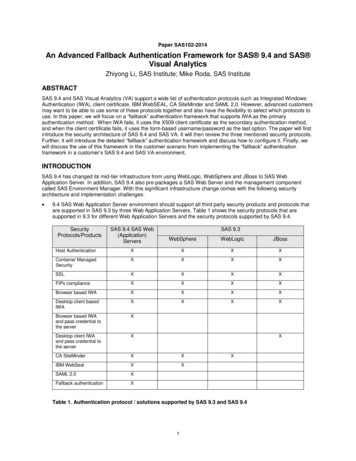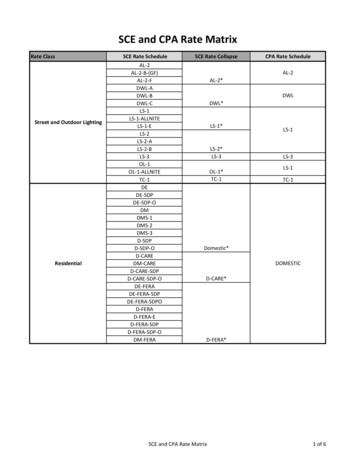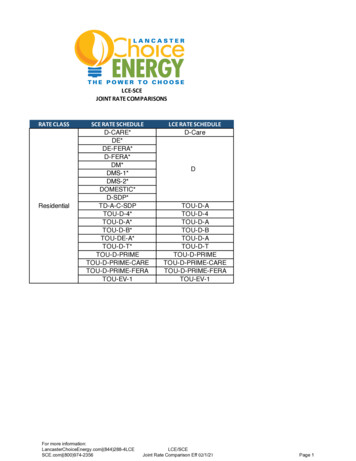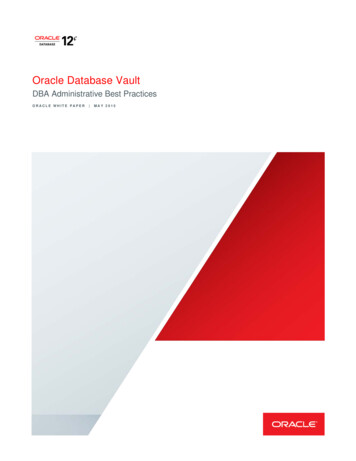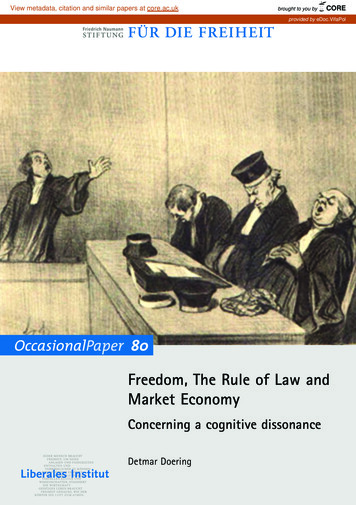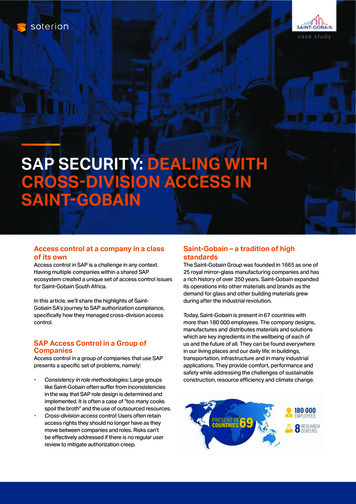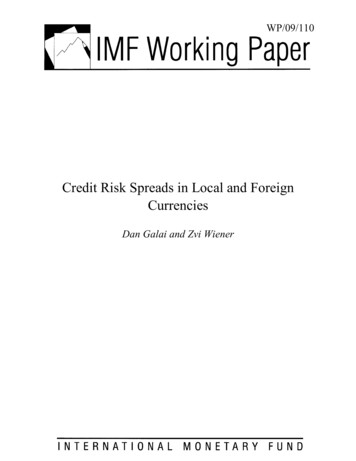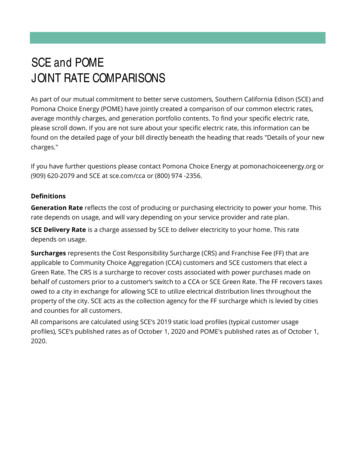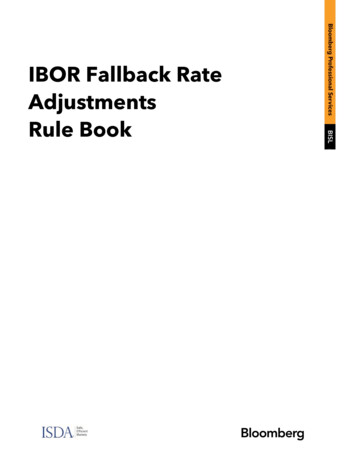
Transcription
BISLIBOR Fallback RateAdjustmentsRule Book
IBOR FALLBACK RATE ADJUSTMENTS RULE BOOKBackgroundInter-bank Offered Rates (“IBORs”), a series of interest rate benchmarks, are undergoing a period ofchange as regulators and industry groups have recommended that firms transition away from theLondon Inter-bank Offered Rate (“LIBOR”) and other IBORs and prepare to replace them with alternative,overnight Risk Free Rates (“RFRs”). These RFRs, including SOFR (USD), STR (EUR) and SONIA (GBP),are typically administered and published by major central banks worldwide.Transitioning to the RFRs will be a demanding and complex process for the industry as RFRs arestructurally different from IBORs. They are overnight rates and exhibit different liquidity characteristicsand supply/demand issues than IBORs.To address the risk that one or more IBORs are discontinued while market participants continue to haveexposure to that rate, counterparties are encouraged to agree to contractual fallback provisions thatwould provide for adjusted versions of the RFRs as replacement rates.Due to the fundamental differences in the nature of IBORs and the RFRs, key adjustments are necessaryif RFR fallbacks are to take effect in contracts that were originally negotiated to reference the IBORs. TheInternational Swaps and Derivatives Association, Inc. (“ISDA”) ran public consultations (“ISDAConsultations”) to finalize the adjustment methodologies for derivatives contracts and subsequentlyissued a tender invitation for a vendor to perform and distribute these necessary adjustments.More information about the ISDA Consultations can be found here.Bloomberg Index Services Limited (“BISL” and, collectively with its affiliates, “Bloomberg”) was selectedas the vendor to calculate and distribute these RFR adjustments (each a “Rate Adjustment” and,collectively, the “Rate Adjustments”), including the Adjusted Reference Rate, the Spread Adjustmentand the resulting Fallback Rate (as such terms are defined below).This rule book (“Rule Book”) sets out the formulae, definitions, rules and conventions that BISL willimplement to calculate the Rate Adjustments in line with the ISDA Consultations referenced above.Without limiting the detail set forth in the formulae, definitions, rules and conventions outlined below,the key adjustments that the ISDA Consultations arrived at and which this Rule Book seeks to implementare the following:(i)(ii)(iii)to account for the fact that IBORs have a term structure (e.g., 1-month, 2-month, etc.) whereasRFRs are overnight rates, the RFRs will be compounded in arrears over a period similar to theapplicable IBOR tenor (e.g., 30 days for 1-month, 60 days for 2-month, etc.). Thesecompounded RFRs are each generally referred to as the “Adjusted Reference Rate”;to account for the (nearly) risk-free nature of the RFRs v. the liquidity characteristics andsupply/demand factors affecting IBORs, a spread adjustment will be calculated for eachRFR/IBOR pair (per tenor) using a five year historical median calculation. These calculationsare each generally referred to as the “Spread Adjustment”; andadding (i) and (ii) together on a per RFR, per tenor basis for the resulting “Fallback Rate”.BISL is authorised and regulated by the Financial Conduct Authority. However, users should note thatthe IBOR transition is to RFRs produced by central banks. The adjustment calculations described in thisRule Book aim to facilitate this transition and the adoption of these RFRs but the Rate Adjustments arenot themselves separate benchmarks for purposes of the EU benchmark regulation (or similarapplicable frameworks) (“BMR”).
Users should be aware that prior to the Spread Adjustment becoming fixed upon a “SpreadAdjustment Fixing Date” (as defined and determined below), neither the Spread Adjustment northe Fallback Rate should be used as a primary reference rate within a financial instrument orfinancial contract (or other ‘use’ as defined in the BMR) other than as a contractual fallback. Useof Bloomberg’s calculations to the contrary is expressly prohibited.Please see the Frequently Asked Questions document on Bloomberg.com/LIBOR for further information.Publication Date: 22nd April 2020Last Updated: 8th October 2020THIS DOCUMENT IS PROPRIETARY TO ISDA, BLOOMBERG AND THEIR RESPECTIVE AFFILIATES.YOU ARE REFERRED TO THE IMPORTANT DISCLAIMERS AND DISCLOSURES IN THIS DOCUMENT.
Table of ContentsSection 1.IntroductionSection 2.Overview of the Rate AdjustmentsSection 3.DefinitionsSection 4.Rate Adjustment CalculationsSection 5.General RulesSection 6.Backtest AssumptionsSection 7.Licensing, Trademark and Important Disclaimer InformationAppendix ARate Adjustment Information
Section 1.IntroductionUnless otherwise specified or defined, all capitalized terms referred to in this Rule Book are defined inSection 3 (“Definitions”).This Rule Book has been made available by the Adjustment Services Vendor and sets out the rulesapplicable to the Rate Adjustments.This version of the Rule Book is provided as of the date specified on the cover of this Rule Book (the“Publication Date”). Upon each update to this Rule Book, the most recent version shall be deemed tosupersede the preceding version from the date of such update such that, in the event of any conflictbetween an earlier version of the Rule Book and the most recent version, the most recent version shallprevail. The Adjustment Services Vendor will use reasonable efforts to provide notice of such updates.The Adjustment Services Vendor shall provide additional information about any such updates uponwritten request.All determinations and calculations made by the Adjustment Services Vendor will (in the absence ofmanifest error) be final, conclusive and binding.The information contained in this Rule Book includes the formulae and material rules and risks relatingto the Rate Adjustments. This information is subject to change.Section 2.2.1Overview of the Rate AdjustmentsDetermination of the Rate AdjustmentsThe Rate Adjustments are calculated by the Adjustment Services Vendor and are based on the value ofeach of the relevant Underlying Rates as determined in accordance with Section 4 (“Rate AdjustmentCalculations”) for each Rate Record Day. The determination of dates used in the calculation is based onthe relevant calendars and exchange schedules available at the time of such determination. On any daywhere a Rate Adjustment is not calculated, no Rate Adjustment shall be published in respect of suchday, subject to the provisions set out below. Certain provisions in this Rule Book are expressed in bothformulaic and descriptive terms. In the event of conflict between a descriptive term and a formula, theformula shall govern.2.2Determination of the value of each Underlying RateThe Rate Adjustments have been established and designed only for the purpose of seeking to achievethe objectives stated in the Background Section. They have not been designed to reflect theperformance of the wider financial markets. The Rate Adjustment shall be a function of the value of therelevant Underlying Rates. In the absence of a Market Disruption Event or Fallback Adjustment Event,the Rate Adjustment shall be calculated in accordance with the formulae (including in circumstanceswhere the market for an Underlying Rate is illiquid or fragmented). This Section 2 (“Overview of the RateAdjustments”) only provides a summary of the Rate Adjustments and is subject to, and qualified by, theremainder of this Rule Book.
Section 3.Definitions“ STR”, or “EuroSTR”, means the euro short-term rate provided by the European Central Bank (ECB),as administrator of the benchmark, (or any successor administrator);“Accrual End Date” means, with respect to an IBOR, its Reference Rate, Tenor and a Rate Record Day,(i)(ii)(iii)if such Tenor is ‘Overnight’ or ‘Spot Next’, the Following Convention Date with respect tosuch Reference Rate and the Calendar Day immediately succeeding the Accrual StartDate; orif such Tenor is ‘1 Week’ or ‘2 Weeks’, the Following Convention Date with respect to suchReference Rate and the Calendar Day that is 7 (seven) or 14 (fourteen) Calendar Daysimmediately succeeding the Accrual Start Date, respectively; orif such Tenor is ‘1 Month’, ‘2 Months’, ‘3 Months’, ‘4 Months’, ‘5 Months’, ‘6 Months’ or ‘12Months’, the Modified Following Convention Date with respect to such Reference Rate andthe Calendar Day that is 1 (one), 2 (two), 3 (three), 4 (four), 5 (five), 6 (six) or 12 (twelve)months immediately succeeding the Accrual Start Date, respectively. For the avoidance ofdoubt, if the day of the month of the Accrual Start Date is not present in the month that is 1(one), 2 (two), 3 (three), 4 (four), 5 (five), 6 (six) or 12 (twelve) months immediatelysucceeding such Accrual Start Date, then the Accrual End Date shall be the ModifiedFollowing Convention Date with respect to such Reference Rate and the last Calendar Dayof the month that is 1 (one), 2 (two), 3 (three), 4 (four), 5 (five), 6 (six) or 12 (twelve) monthsimmediately succeeding the month of the Accrual Start Date, respectively;“Accrual Spot Date” means, with respect to an IBOR, its Reference Rate, Tenor and a Rate RecordDay, the Reference Rate Business Day that is the Reference Spot Lag number of Reference RateBusiness Days immediately following such Rate Record Day. For the avoidance of doubt, if theReference Spot Lag is 0 (zero) and such Rate Record Day is not also a Reference Rate Business Day,then the Accrual Spot Date is the Reference Rate Business Day immediately following such RateRecord Day;“Accrual Start Date” means, with respect to an IBOR, its Reference Rate, Tenor and a Rate RecordDay, the Reference Rate Business Day that is the Offset Lag number of Reference Rate Business Daysimmediately prior to the Accrual Spot Date;“Adjusted Reference Rate” means, with respect to an IBOR, Tenor and Rate Record Day, the ratecalculated in accordance with the methodology described in Section 4.2 (“Calculation of AdjustedReference Rate”);“Adjusted Reference Rate Base Date” means, with respect to an IBOR and Tenor, the date listedunder column ‘Adjusted Reference Rate Base Date’ in Table 1 (“Fallback Rate Information”) in AppendixA;“Adjustment Services Vendor”, or “Vendor” means Bloomberg Index Services Limited;“Affiliate” means in relation to any entity, any other entity directly or indirectly controlling, controlledby, or under common control with, such entity;“BBSW” means the Australian Dollar rate for prime bank eligible securities, known as the Bank Bill
Swap Rate, provided by the IBOR Administrator;“Bloomberg Page” means, with respect to a Bloomberg ticker, the page on the BloombergTerminal generated by entering such ticker GO ;“Bloomberg Website” means the olution/libor-transition/ or any successor thereto;“Business Day” means each IBOR Business Day and each Reference Rate Business Day;“Calendar Day” means all days, including weekends and holidays;“CDOR” means the Canadian Dollar rate for banker’s acceptance borrowings, known as the CanadianDollar Offered Rate, provided by the IBOR Administrator;“CORRA” means the Canadian Overnight Repo Rate Average provided by Refinitiv BenchmarkServices (UK) Limited (RBSL), as administrator of the benchmark, or any successor administrator;“Data Source” means(i)(ii)with respect to a Reference Rate and its Reference Rate Bloomberg Ticker, the BloombergPage; orwith respect to an IBOR and its IBOR Bloomberg Ticker, the Bloomberg Page;“Day Count” means(i)(ii)with respect to a Reference Rate, the number of days listed under column ‘Day Count’ inTable 4 (“Reference Rate Information”) in Appendix A; orwith respect to an IBOR, the number of days listed under column ‘Day Count’ in Table 2(“IBOR Information”) in Appendix A;“EONIA” means the Euro Overnight Index Average currently provided by the European MoneyMarkets Institute (EMMI) as administrator of the benchmark;“EURIBOR” means the Euro wholesale funding rate, known as the Euro Interbank Offered Rate,provided by the IBOR Administrator;“Euro LIBOR” means the Euro wholesale funding rate, known as the Euro London Interbank OfferedRate, provided by the IBOR Administrator;“Euroyen TIBOR” means the prevailing market rate for prime bank transactions in the Japan offshoremarket, known as the Euroyen Tokyo Interbank Offered Rate, provided by the IBOR Administrator;“Fallback Adjustment Event” means, with respect to a Rate Adjustment, the administrator of therelevant Reference Rate permanently discontinues the Reference Rate;“Fallback Rate” means, with respect to an IBOR, Tenor and Rate Record Day, the rate calculated inaccordance with the methodology described in Section 4.1 (“Calculation of Fallback Rate”);“Fallback Rate Base Date” means, with respect to an IBOR and Tenor, the date listed under column‘Fallback Rate Base Date’ in Table 1 (“Fallback Rate Information”) in Appendix A;“Following Convention Date” means,(i)(ii)with respect to a date and a Reference Rate, such date if it is a Reference Rate BusinessDay, otherwise the immediately succeeding Reference Rate Business Day; orwith respect to a date, an IBOR and Tenor, such date if it is an IBOR Business Day,otherwise the immediately succeeding IBOR Business Day;
“Force Majeure Event” means an event or circumstance (including, without limitation, a systemsfailure, natural or man-made disaster, act of God, armed conflict, act of terrorism, riot or labourdisruption or any similar intervening circumstance) that is beyond the reasonable control of theAdjustment Services Vendor and that the Adjustment Services Vendor determines affects a RateAdjustment, any Underlying Rate or the methodology on which the relevant Rate Adjustment is basedor the Adjustment Services Vendor’s ability to calculate and publish the relevant Rate Adjustment;“HIBOR” means the rate of interest offered on Hong Kong Dollar loans by banks in the interbankmarket, known as the Hong Kong Interbank Offered Rate, provided by the IBOR Administrator;“HONIA” means the Hong Kong Dollar Overnight Index Average provided by the Treasury MarketsAssociation (TMA), as administrator of the benchmark, or any successor administrator;“IBOR” means each Interbank Offered Rate (IBOR) listed under column ‘IBOR’ in Table 1 (“FallbackRate Information”) in Appendix A;“IBOR Administrator” means, with respect to an IBOR, the administrator of the benchmark listedunder column ‘IBOR Administrator’ in Table 2 (“IBOR Information”) in Appendix A (or any successoradministrator thereto);“IBOR Bloomberg Ticker” means, with respect to an IBOR and Tenor, the ticker listed under column‘Bloomberg Ticker’ in Table 3 (“IBOR Tenor Information”) in Appendix A;“IBOR Business Day” means, with respect to an IBOR and Tenor, the days defined under column‘Business Days’ in Table 2 (“IBOR Information”) in Appendix A;“IBOR Cessation Trigger Date” means, with respect to an IBOR and with respect to the defined termsused in this Rule Book, the date on which there is:(i)(ii)(iii)a public statement or publication of information by or on behalf of the IBOR Administratorannouncing that it has ceased or will cease to provide the IBOR permanently orindefinitely, provided that, at the time of the statement or publication, there is nosuccessor administrator that will continue to provide the IBOR; ora public statement or publication of information by the regulatory supervisor for the IBORAdministrator, the central bank for the currency of the IBOR, an insolvency official withjurisdiction over the administrator for the IBOR, a resolution authority with jurisdiction overthe administrator for the IBOR or a court or an entity with similar insolvency or resolutionauthority over the administrator for the IBOR, which states that the IBOR Administrator hasceased or will cease to provide the IBOR permanently or indefinitely, provided that, at thetime of the statement or publication, there is no successor administrator that will continueto provide the IBOR; orif the IBOR is Sterling LIBOR, Swiss Franc LIBOR, U.S. Dollar LIBOR, Euro LIBOR or YenLIBOR only, a public statement or publication of information by the regulatory supervisorfor the IBOR Administrator of such IBOR announcing that (a) the regulatory supervisor hasdetermined that such IBOR is no longer, or as of a specified future date will no longer be,representative of the underlying market and economic reality that such IBOR is intendedto measure and that representativeness will not be restored and (b) it is being made in theawareness that the statement or publication will engage certain contractual triggers forfallbacks activated by pre-cessation announcements by such supervisor (howsoeverdescribed) in contracts;“IBOR Maturity Date” means, with respect to an IBOR, Tenor and Median Period Day,
(i)(ii)(iii)if such Tenor is ‘Overnight’ or ‘Spot Next’, the Following Convention Date with respect tosuch IBOR, Tenor and the Calendar Day immediately succeeding the IBOR Value Date; orif such Tenor is ‘1 Week’ or ‘2 Weeks’, the Following Convention Date with respect to suchIBOR, Tenor and the day that is 7 (seven) or 14 (fourteen) Calendar Days immediatelysucceeding the IBOR Value Date, respectively; orif such Tenor is ‘1 Month’, ‘2 Months’, ‘3 Months’, ‘4 Months’, ‘5 Months’, ‘6 Months’ or ’12Months’, the Modified Following Convention Date with respect to such IBOR, Tenor andthe Calendar Day that is 1 (one), 2 (two), 3 (three), 4 (four), 5 (five), 6 (six) or 12 (twelve)months immediately succeeding the IBOR Value Date, respectively. For the avoidance ofdoubt, if the day of the month of the IBOR Value Date is not present in the month that is 1(one), 2 (two), 3 (three), 4 (four), 5 (five), 6 (six) or 12 (twelve) months immediatelysucceeding such IBOR Value Date, then the IBOR Maturity Date shall be the ModifiedFollowing Convention Date with respect to such IBOR, Tenor and the last Calendar Day ofthe month that is 1 (one), 2 (two), 3 (three), 4 (four), 5 (five), 6 (six) or 12 (twelve) monthsimmediately succeeding the month of the IBOR Value Date, respectively;“IBOR Value Date” means, with respect to an IBOR, Tenor and an IBOR Business Day, the IBORBusiness Day that is the IBOR Value Lag number of IBOR Business Days immediately following suchIBOR Business Day;“IBOR Value Lag” means, with respect to an IBOR and Tenor, 0 (zero) if the Tenor is Overnight,otherwise the number listed under column ‘Value Lag’ in Table 2 (“IBOR Information”) in Appendix A;“Live Tenor” means, with respect to an IBOR and a date, the set of Tenors for which such date is priorto the Tenor Cessation Trigger Date;“Lower Interpolation Tenor” means, with respect to an IBOR, a Tenor and a Median Period Day, thelongest Live Tenor that is shorter than such Tenor;“Market Disruption Event” means, with respect to a Rate Adjustment, the occurrence of one or moreof the following events:(i)(ii)(iii)the occurrence of an event that makes it impossible or not reasonably practicable for theAdjustment Services Vendor to obtain the value of any Underlying Rate, or any other priceor necessary information for purposes of calculating the Rate Adjustment;a temporary failure by the administrator or other source of an Underlying Rate toannounce or publish the level or value of such Underlying Rate on a day on which the levelor value of such Underlying Rate was scheduled to be announced or published;a Force Majeure Event;“Median Period” means, with respect to an IBOR, Tenor and Rate Record Day, the set of daysoccurring in the period from and including the Median Period Start Date to and including the MedianPeriod End Date that are Median Period Days for which the Accrual End Date of the AdjustedReference Rate for each day is at least 2 (two) Reference Rate Business Days earlier than such RateRecord Day;“Median Period Days” means, with respect to an IBOR and Tenor, days that are both IBOR BusinessDays and Rate Record Days;“Median Period End Date” means, with respect to an IBOR, Tenor and Rate Record Day, the dayoccurring 2 (two) Reference Rate Business Days immediately prior to the date that is the Tenor periodimmediately prior to the Rate Record Day;
“Median Period Start Date” means, with respect to a Median Period End Date, the Calendar Dayoccurring 5 (five) years prior to such Median Period End Date. For the avoidance of doubt, if suchMedian Period End Date is the 29th (twenty ninth) of February and the year occurring 5 (five) yearsprior to such Median Period End Date is not a leap year, then the Median Period Start Date means theCalendar Day occurring 5 (five) years prior to the Calendar Day immediately preceding such MedianPeriod End Date;“Modified Following Convention Date” means,(i)(ii)with respect to a date and a Reference Rate, such date if it is a Reference Rate BusinessDay, otherwise the immediately succeeding Reference Rate Business Day if it falls in thesame month as such date, otherwise the immediately preceding Reference Rate BusinessDay; orwith respect to a date, an IBOR and Tenor, such date if it is an IBOR Business Day,otherwise the immediately succeeding IBOR Business Day if it falls in the same month assuch date, otherwise the immediately preceding IBOR Business Day;“Offset Lag” means 2 (two);“Product” has the meaning given to it in the ‘Important Disclaimer Information’ section;“Product Investor” has the meaning given to it in the ‘Important Disclaimer Information’ section;“Rate Adjustment” has the meaning given to it in the ‘Background’ section;“Rate Adjustment Commencement Date” means, with respect to an IBOR and Tenor, the date listedunder column ‘Commencement Date’ in Table 1 (“Fallback Rate Information”) in Appendix A;“Rate Record Day” means each day of the week other than Saturday or Sunday;“RBA Cash Rate” means the Reserve Bank of Australia cash rate provided by the Reserve Bank ofAustralia, as administrator of the benchmark, or any successor administrator;“Reference Rate” means, with respect to an IBOR, the rate listed under column ‘Reference Rate’ inTable 1 (“Fallback Rate Information”) in Appendix A;“Reference Rate Bloomberg Ticker” means, with respect to a Reference Rate, the ticker listed undercolumn ‘Bloomberg Ticker’ in Table 4 (“Reference Rate Information”) in Appendix A;“Reference Rate Business Day” means, with respect to a Reference Rate, the days defined undercolumn ‘Business Days’ in Table 4 (“Reference Rate Information”) in Appendix A;“Reference Spot Lag” means, with respect to a Reference Rate and Tenor, 0 (zero) if the Tenor isOvernight, otherwise the number listed under column ‘Spot Lag’ in Table 4 (“Reference RateInformation”) in Appendix A;“Rounding Precision” means, with respect to a Reference Rate, the percentage specified undercolumn ‘Rounding Precision’ in Table 4 (“Reference Rate Information”) in Appendix A;“SOFR” means the daily Secured Overnight Financing Rate provided by the Federal Reserve Bank ofNew York, as administrator of the benchmark (or any successor administrator);“SARON” means the Swiss Average Rate Overnight rate provided by SIX Financial Information AG(SIX), as administrator of the benchmark or any successor administrator;“SONIA” means the daily Sterling Overnight Index Average rate as provided by the administrator, orany successor administrator, of the benchmark to and published by authorized distributors;
“Spread Adjustment” means, with respect to an IBOR, Tenor and Rate Record Day, the ratecalculated in accordance with the methodology described in Section 4.3 (“Calculation of SpreadAdjustment”);“Spread Adjustment Base Date” means, with respect to an IBOR and Tenor, the date listed undercolumn ‘Spread Adjustment Base Date’ in Table 1 (“Fallback Rate Information”) in Appendix A;“Spread Adjustment Fixing Date” means, with respect to an IBOR and Tenor, the earlier of,(i)(ii)the IBOR Cessation Trigger Date, andthe Tenor Cessation Trigger Date or, if later, the last date for which there is both a LiveTenor that is shorter than such Tenor and a Live Tenor that is longer than such Tenor;“Sterling LIBOR” means the Sterling wholesale funding rate, known as the Sterling London InterbankOffered Rate, provided by the IBOR Administrator;“Swiss Franc LIBOR” means the Swiss Franc wholesale funding rate, known as the Swiss FrancLondon Interbank Offered Rate, provided by the IBOR Administrator;“Tenor” means, with respect to an IBOR, each tenor listed under column ‘Tenor’ in Table 3 (“IBORTenor Information”) in Appendix A;“Tenor Cessation Trigger Date” means, with respect to an IBOR and Tenor, the date on which thereis,(i)(ii)(iii)a public statement or publication of information by or on behalf of the IBOR Administratorannouncing that it has ceased or will cease to provide the IBOR Tenor permanently orindefinitely, provided that, at the time of the statement or publication, there is nosuccessor administrator that will continue to provide the IBOR Tenor; ora public statement or publication of information by the regulatory supervisor for the IBORAdministrator, the central bank for the currency of the IBOR, an insolvency official withjurisdiction over the administrator for the IBOR, a resolution authority with jurisdiction overthe administrator for the IBOR or a court or an entity with similar insolvency or resolutionauthority over the administrator for the IBOR, which states that the IBOR Administrator hasceased or will cease to provide the IBOR Tenor permanently or indefinitely, provided that,at the time of the statement or publication, there is no successor administrator that willcontinue to provide the IBOR Tenor; orif the IBOR is Sterling LIBOR, Swiss Franc LIBOR, U.S. Dollar LIBOR, Euro LIBOR or YenLIBOR only, a public statement or publication of information by the regulatory supervisorfor the IBOR Administrator of such IBOR announcing that (a) the regulatory supervisor hasdetermined that such IBOR Tenor is no longer, or as of a specified future date will nolonger be, representative of the underlying market and economic reality that such IBORTenor is intended to measure and that representativeness will not be restored and (b) it isbeing made in the awareness that the statement or publication will engage certaincontractual triggers for fallbacks activated by pre-cessation announcements by suchsupervisor (howsoever described) in contracts;“TONA” means the Tokyo Overnight Average rate provided by the Bank of Japan, as administrator ofthe benchmark, or any successor administrator;“Underlying Rate” means each IBOR and each Reference Rate;“Upper Interpolation Tenor” means, with respect to an IBOR, a Tenor and a Median Period Day, the
shortest Live Tenor that is longer than such Tenor;“U.S. Dollar LIBOR” means the U.S. Dollar wholesale funding rate, known as the U.S. Dollar LondonInterbank Offered Rate, provided by the IBOR Administrator;“Value” means,(i)(ii)with respect to a Reference Rate and a Calendar Day, the rate published on the DataSource for such Calendar Day if such Calendar Day is also a Reference Rate Business Day,otherwise the rate published on the Data Source for the immediately preceding ReferenceRate Business Day; orwith respect to an IBOR, Tenor and a Calendar Day, the rate published on the Data Sourcefor such Calendar Day if such Calendar Day is also an IBOR Business Day, otherwise therate published on the Data Source for the immediately preceding IBOR Business Day;“Yen LIBOR” means the Yen wholesale funding rate, known as the Yen London Interbank OfferedRate, provided by the IBOR Administrator; and“Yen TIBOR” means the prevailing market rate in the Japan unsecured call market, known as theJapanese Yen Tokyo Interbank Offered Rate, provided by the IBOR Administrator.Section 4.Rate Adjustment CalculationsCalculation of Fallback RateThe Fallback Rate, 𝐹𝐹𝐹𝐹, with respect to an IBOR, each Tenor 𝑓𝑓 and each Rate Record Day 𝑡𝑡 on andfollowing the Fallback Rate Base Date, shall be calculated by the Adjustment Services Vendor inaccordance with the following formula, and rounded to the nearest Rounding Precision (breaking tiesby rounding half away from zero):𝐹𝐹𝑅𝑅𝑓𝑓,𝑡𝑡 𝐴𝐴𝐴𝐴𝑅𝑅𝑓𝑓,𝑡𝑡 �𝑅𝑓𝑓,𝑡𝑡 means the Fallback Rate for Tenor 𝑓𝑓 on Rate Record Day 𝑡𝑡;𝐴𝐴𝐴𝐴𝑅𝑅𝑓𝑓,𝑡𝑡 means the Adjusted Reference Rate for Tenor 𝑓𝑓 on Rate Record Day 𝑡𝑡; and𝑆𝑆𝐴𝐴𝑓𝑓,𝑡𝑡 means the Spread Adjustment for Tenor 𝑓𝑓 on Rate Record Day 𝑡𝑡.Calculation of Adjusted Reference RateThe Adjusted Reference Rate, 𝐴𝐴𝐴𝐴𝐴𝐴, with respect to an IBOR, each Tenor 𝑓𝑓 and each Rate Record Day 𝑡𝑡on and following the Adjusted Reference Rate Base Date, shall be calculated by the AdjustmentServices Vendor in accordance with the following formula, and rounded to the nearest RoundingPrecision (breaking ties by rounding half away from zero):𝐴𝐴𝐴𝐴𝐴𝐴𝑓𝑓,𝑡𝑡 𝐷𝐷𝐷𝑡𝑡𝐼𝐼1 1 𝛿𝛿𝑢𝑢,𝑢𝑢 1 𝑅𝑅𝑅𝑅𝑅𝑅𝑢𝑢 1 ��𝐷𝑡𝑡𝑅𝑅𝑅𝑅 ,𝑡𝑡𝑢𝑢 ���𝑅𝑓𝑓,𝑡𝑡 means the Adjusted Reference Rate for Tenor 𝑓𝑓 on Rate Record Day 𝑡𝑡;
��𝐷𝑡𝑡𝐼𝐼 means, with respect to the IBOR, the Day 𝐷𝐷𝐷𝑡𝑡𝑅𝑅𝑅𝑅 means, with respect to the Reference Rate, the Day Count;𝑆𝑆𝑓𝑓,𝑡𝑡 means, with respect to Tenor 𝑓𝑓 and Rate Record Day 𝑡𝑡, the Accrual Start Date;𝐸𝐸𝑓𝑓,𝑡𝑡 means, with respect to Tenor 𝑓𝑓 and Rate Record Day 𝑡𝑡, the Accrual End �𝑓,𝑡𝑡 means, with respect to Accrual Start Date 𝑆𝑆𝑓𝑓,𝑡𝑡 and Accrual End Date 𝐸𝐸𝑓𝑓,𝑡𝑡 , the day countfraction calculated in accordance with the following ��𝐸𝑓𝑓,𝑡𝑡 Days 𝑆𝑆𝑓𝑓,𝑡𝑡 , 𝐸𝐸𝑓𝑓,𝑡𝑡 ��𝐷𝑡𝑡𝑅𝑅𝑅𝑅Days 𝑆𝑆𝑓𝑓,𝑡𝑡 , 𝐸𝐸𝑓𝑓,𝑡𝑡 means the number of Calendar Days from and including Accrual Start Date 𝑆𝑆𝑓𝑓,𝑡𝑡 toand excluding Accrual End Date 𝐸𝐸𝑓𝑓,𝑡𝑡 ;𝐴𝐴𝐴𝐴𝑓𝑓,𝑡𝑡 means the set of Reference Rate Business Days occurring in the period from and including theAccrual Start Date 𝑆𝑆𝑓𝑓,𝑡𝑡 , to and excluding the Accrual End Date 𝐸𝐸𝑓𝑓,𝑡𝑡 ;𝑢𝑢 means a Reference Rate Business Day;𝑢𝑢 1 means the Reference Rate Business Day i
then the Accrual Spot Date is the Reference Rate Business Day immediately following such Rate Record Day; "Accrual Start Date" means, with respect to an IBOR, its Reference Rate, Tenor and a Rate Record Day, the Reference Rate Business Day that is the Offset Lag number of Reference Rate Business Days immediately prior to the Accrual Spot Date;
